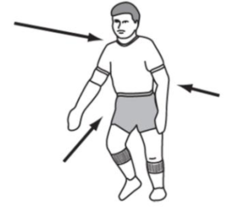
BASIC BIOMECHANICS
8th Edition
ISBN: 9781259913877
Author: Hall
Publisher: RENT MCG
expand_more
expand_more
format_list_bulleted
Concept explainers
Textbook Question
Chapter 3, Problem 3IP
A rugby player is contacted simultaneously by three opponents who exert forces of the magnitudes and directions shown in the diagram at right. Using a graphic solution, show the magnitude and direction of the resultant force.

Expert Solution & Answer
Want to see the full answer?
Check out a sample textbook solution
Chapter 3 Solutions
BASIC BIOMECHANICS
Ch. 3 - Prob. 1IPCh. 3 - How much force must be applied to a 0.5-kg hockey...Ch. 3 - A rugby player is contacted simultaneously by...Ch. 3 - Prob. 4IPCh. 3 - Draw the horizontal and vertical components of the...Ch. 3 - A gymnastics floor mat weighing 220 N has...Ch. 3 - What is the volume of a milk crate with sides of...Ch. 3 - Prob. 8IPCh. 3 - If the contents of the crate described in Problem...Ch. 3 - Two children sit on opposite sides of a playground...
Ch. 3 - Prob. 1APCh. 3 - Gravitational force on planet X is 40% of that...Ch. 3 - A football player is contacted by two tacklers...Ch. 3 - A 75-kg skydiver in free fall is subjected to a...Ch. 3 - Use a trigonometric solution to find the magnitude...Ch. 3 - Prob. 6APCh. 3 - In the nucleus pulposus of an intervertebral disc,...Ch. 3 - Prob. 9APCh. 3 - Two muscles develop tension simultaneously on...
Knowledge Booster
Learn more about
Need a deep-dive on the concept behind this application? Look no further. Learn more about this topic, bioengineering and related others by exploring similar questions and additional content below.Recommended textbooks for you
- Case Studies In Health Information ManagementBiologyISBN:9781337676908Author:SCHNERINGPublisher:Cengage
 Principles Of Radiographic Imaging: An Art And A ...Health & NutritionISBN:9781337711067Author:Richard R. Carlton, Arlene M. Adler, Vesna BalacPublisher:Cengage Learning
Principles Of Radiographic Imaging: An Art And A ...Health & NutritionISBN:9781337711067Author:Richard R. Carlton, Arlene M. Adler, Vesna BalacPublisher:Cengage Learning



Case Studies In Health Information Management
Biology
ISBN:9781337676908
Author:SCHNERING
Publisher:Cengage


Principles Of Radiographic Imaging: An Art And A ...
Health & Nutrition
ISBN:9781337711067
Author:Richard R. Carlton, Arlene M. Adler, Vesna Balac
Publisher:Cengage Learning

Chapter 7 - Human Movement Science; Author: Dr. Jeff Williams;https://www.youtube.com/watch?v=LlqElkn4PA4;License: Standard youtube license